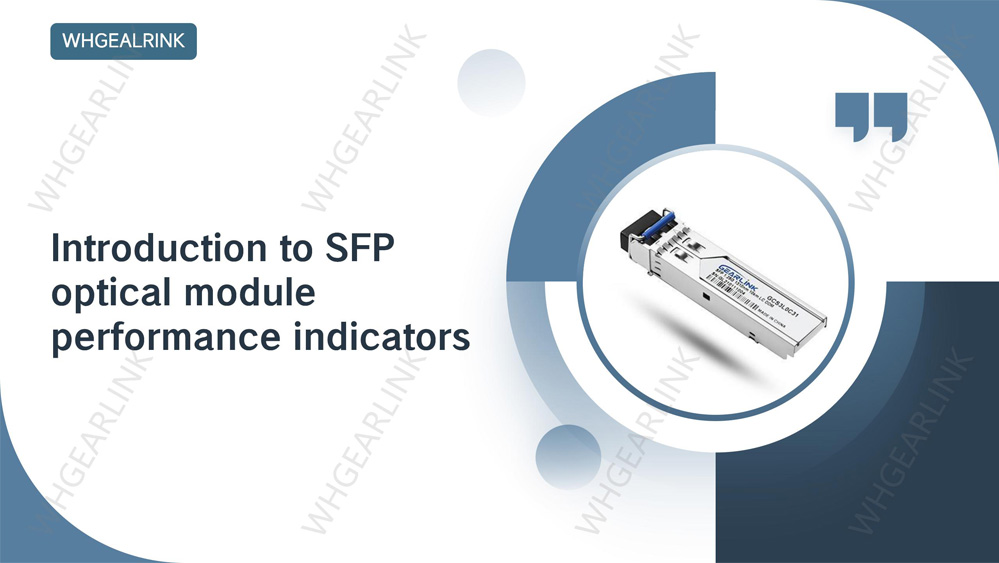
Abstract
The SFP optical module is a small pluggable photoelectric conversion module, which has the characteristics of small size, pluggability, and stable performance. Its common performance indicators include transmission rate, wavelength, transmitted optical power, receiving sensitivity, saturated optical power, transmission distance and operating temperature.
Text
The SFP optical module is a small pluggable photoelectric conversion module, which has the characteristics of small size, pluggability, and stable performance. It is widely used in various optical fiber transmission systems and is used as the interface between transmission equipment and network equipment. When selecting and using SFP optical modules, it is very important to understand their performance indicators. Below we will introduce the common performance indicators and functions of SFP optical modules.
Transmission rate: SFP optical modules support different rate levels, such as 155Mb/s, 622Mb/s, 1.25Gb/s, 2.5Gb/s, 4.25Gb/s, etc. These rates represent the maximum speed that the optical module can support. The more common ones currently are 155M and 1.25G.
Wavelength: The wavelength of light refers to the frequency of the optical signal. The transmission effects of optical signals of different wavelengths in optical fibers will be different. Common SFP optical module wavelengths include 850nm, 1310nm and 1550nm, CWDM and DWDM. These optical modules with different wavelengths are suitable for different transmission distances.
Transmitted optical power: refers to the output optical power of the light source at the transmitting end of the optical module. It determines the intensity of the optical signal emitted by the optical module and affects the transmission quality and transmission distance of the optical signal in the optical fiber. Generally speaking, the greater the emitted optical power, the farther the transmission distance.
Receiving sensitivity: The sensitivity range of the optical module refers to the optical signal intensity range that the optical module can receive. Usually the higher the rate, the worse the receiving sensitivity. It determines the minimum intensity of the optical signal that the optical module can receive, affecting the transmission distance and system performance of the optical signal.
Saturated optical power: Also known as optical saturation, it refers to the maximum input optical power when maintaining a certain bit error rate at a certain rate. For long-distance optical modules, since their average output optical power is generally greater than their saturated optical power, special attention needs to be paid to the length of the optical fiber used to ensure that the actual received optical power of the optical module is less than its optical saturation to avoid damage to the optical module.
Transmission distance: It is jointly determined by the transmitting optical power, receiving sensitivity and fiber attenuation of the optical module, which limits the transmission range of the optical module in the optical fiber. optical modules with different parameters are suitable for different transmission distances.
Fiber interface type: determines the connection method between the optical module and the optical fiber, including SC, LC, FC, etc., which affects the applicable scope and system performance of the optical module.
Operating temperature: refers to the normal operating temperature range of the SFP optical module, which is divided into commercial grade, expansion grade, industrial grade, etc. SFP optical modules generate heat when working. If the temperature exceeds its operating temperature range, the performance of the optical module may be reduced or even damaged. The operating temperature range can be divided into commercial grade, extended grade and industrial grade optical modules. Commercial-grade optical modules are suitable for ordinary office environments, and the operating temperature range is generally between 0°C and 70°C. Extended optical modules are suitable for some special environments, and the operating temperature range can reach between -20°C and 85°C. Industrial-grade optical modules are suitable for harsh environments, and the operating temperature range can reach between -40°C and 85°C.
Data diagnosis function: refers to the function embedded inside the SFP optical module for monitoring and diagnosing the link. Through the data diagnosis function, users can monitor the working status of the optical module and the quality of the optical signal in real time, and perform fault diagnosis and troubleshooting. The data diagnostic function is very important when maintaining and managing optical modules.
Power consumption: Power consumption refers to the power consumed by the SFP optical module during normal operation. The level of power consumption directly affects the energy consumption and heat dissipation of the device. When selecting SFP optical modules, users need to choose appropriate optical modules based on actual energy and heat dissipation conditions.
In addition to the above main performance indicators, SFP optical modules also have hot-swappable features and unified standards, making SFP products from various manufacturers compatible. At the same time, you also need to pay attention to the compatibility of the optical module with brand equipment and the stability of the optical module to ensure reliable operation of the system. Knowing and understanding the performance indicators of SFP optical modules is crucial to the correct selection and use of optical module. Different performance indicators reflect the characteristics and capabilities of optical modules in different aspects. Users need to make comprehensive considerations based on actual needs when selecting, and select SFP optical modules that meet the requirements. At the same time, proper use and maintenance of optical modules can also extend their service life and ensure transmission quality.

